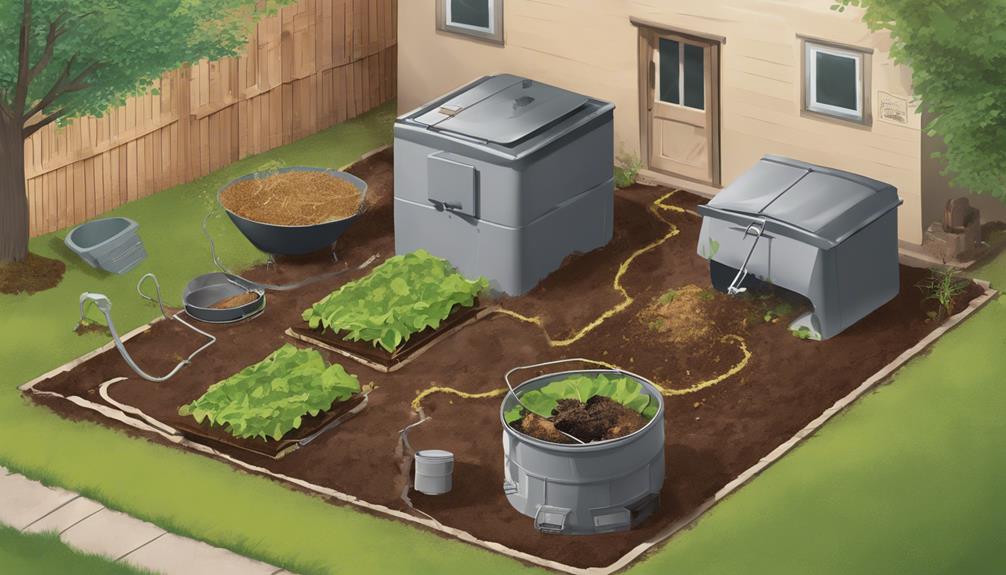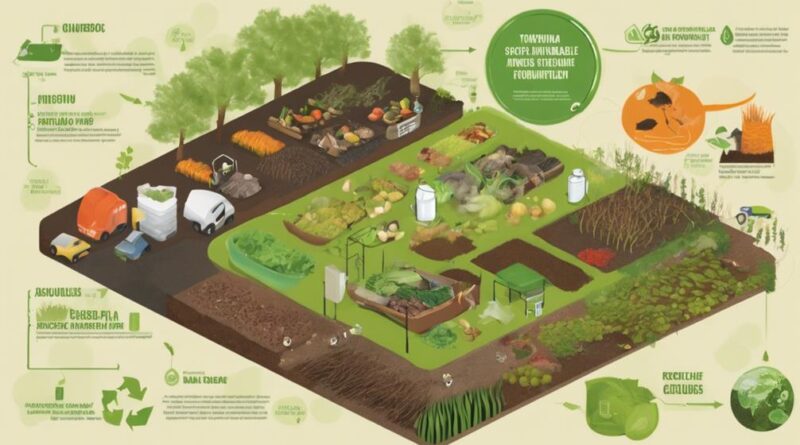7 Best Methods for Recycling Food Waste Sustainably
When it comes to recycling food waste sustainably, consider these seven best methods: Composting turns scraps into nutrient-rich soil. Vermicomposting uses worms to produce compost and improve soil health. Anaerobic digestion creates biogas from organics, reducing greenhouse gas emissions. Bokashi fermentation enhances soil fertility with microbes. Community food waste sharing redistributes surplus food and builds community connections. Repurposing food waste as animal feed promotes sustainability and nutrition. Lastly, converting organic waste into bioenergy reduces emissions and offers a renewable energy solution. These methods offer effective ways to reduce waste and benefit the environment and society.
Composting Food Scraps
Composting food scraps is a highly effective method for diverting organic waste from landfills and creating nutrient-rich soil amendments. By composting your food scraps, you can significantly reduce the amount of waste that ends up in landfills, ultimately helping to lessen the environmental impact of organic waste disposal.
Food scraps are rich in essential nutrients that are beneficial for soil health. When food scraps are composted, they break down into nutrient-rich soil amendments that can enhance soil fertility and structure. This nutrient-rich soil helps to support plant growth and overall soil health, creating a sustainable and natural alternative to chemical fertilizers.
Moreover, by composting food scraps, you're actively participating in reducing landfill waste. Food waste in landfills produces methane, a potent greenhouse gas that contributes to climate change. Through composting, you can prevent food waste from decomposing anaerobically in landfills and releasing harmful greenhouse gases into the atmosphere.
Incorporating composted food scraps into your gardening or farming practices not only enriches the soil but also closes the loop on organic waste disposal. It's a simple yet impactful way to contribute to a more sustainable and eco-friendly approach to managing food waste. By composting your food scraps, you aren't only creating nutrient-rich soil but also actively reducing the amount of waste that goes to landfills.
Vermicomposting for Kitchen Waste
Utilize vermicomposting as a sustainable method for managing kitchen waste effectively while promoting soil health and reducing environmental impact. Vermicomposting involves using a worm bin to break down organic matter. This process not only diverts kitchen scraps from landfills but also produces nutrient-rich compost that enhances soil fertility.
Worm bins are simple to set up and maintain, making them an ideal solution for households looking to reduce their environmental footprint. The worms in the bin consume food waste, breaking it down into castings—a valuable soil amendment. The castings produced through vermicomposting are rich in essential nutrients like nitrogen, phosphorus, and potassium, making them an excellent natural fertilizer for plants.
In addition to managing kitchen waste, vermicomposting plays a crucial role in soil enrichment. The nutrient-dense compost produced from vermicomposting helps improve soil structure, water retention, and microbial activity. By incorporating vermicompost into your garden or potted plants, you can boost plant growth and reduce the need for chemical fertilizers.
Anaerobic Digestion of Organics
To further enhance your sustainable food waste management practices, consider exploring anaerobic digestion of organics as a viable method for efficiently converting waste into valuable resources. Anaerobic digestion is a process where microorganisms break down organic materials in the absence of oxygen, producing biogas and nutrient-rich digestate. This method presents a sustainable solution for handling food waste on a larger scale, offering environmental benefits and energy generation opportunities.
One of the key advantages of anaerobic digestion is biogas generation. Biogas is a renewable energy source primarily composed of methane and carbon dioxide. By capturing and utilizing biogas, facilities can produce heat and electricity, thereby reducing reliance on fossil fuels and lowering greenhouse gas emissions. This waste-to-energy conversion process not only helps in managing food waste but also contributes to the transition towards a more sustainable energy mix.
Moreover, anaerobic digestion can significantly reduce the volume of organic waste that would otherwise end up in landfills. Landfills are major sources of methane emissions, a potent greenhouse gas contributing to climate change. By diverting organic waste to anaerobic digesters, you can mitigate these emissions while producing valuable resources. Additionally, the nutrient-rich digestate remaining after the digestion process can be used as a natural fertilizer, closing the loop in sustainable waste management practices.
Bokashi Fermentation Method
Exploring the Bokashi fermentation method offers an innovative approach to efficiently manage food waste while producing nutrient-rich soil amendments. This method involves fermenting food waste using a mix of beneficial microbes, typically lactic acid bacteria and yeasts, in an anaerobic environment. Here's why the Bokashi fermentation method stands out:
- Microbial Diversity: Bokashi fermentation promotes the growth of diverse microorganisms that break down food waste effectively. The presence of various beneficial microbes helps in accelerating the fermentation process and enhancing the nutrient content of the final compost.
- Carbon Sequestration: By fermenting food waste through the Bokashi method, carbon sequestration is promoted. This process helps in locking away carbon from the atmosphere, reducing greenhouse gas emissions. The resulting compost can then be used to enrich soil health and support plant growth, contributing to a more sustainable environment.
- Nutrient-Rich Soil Amendments: The end product of Bokashi fermentation is a nutrient-dense compost that can improve soil fertility. The fermented food waste is rich in essential nutrients like nitrogen, phosphorus, and potassium, providing plants with the nourishment they need to thrive. This nutrient-rich compost acts as a natural fertilizer, reducing the reliance on synthetic alternatives and promoting a more eco-friendly gardening approach.
Community Food Waste Sharing
Community Food Waste Sharing initiatives connect individuals and organizations to redistribute surplus food, minimizing waste and maximizing resource utilization in a sustainable manner. One effective way this is achieved is through food swap events. These events bring together community members to exchange excess produce, homemade goods, or other food items. By participating in food swap events, not only are you reducing food waste at a local level, but you're also fostering a sense of community and promoting sustainable practices.
Another impactful method of community food waste sharing is through community gardens. These shared green spaces allow members of the community to grow fruits, vegetables, and herbs collectively. Any surplus produce from these community gardens can be shared among participants or donated to those in need, thereby reducing food waste while promoting access to fresh and locally grown foods.
Engaging in community food waste sharing not only helps in minimizing food waste but also contributes to building stronger community ties and promoting sustainable living practices. By participating in food swap events and supporting community gardens, you play a vital role in reducing food waste and creating a more sustainable food system within your community.
Food Waste to Animal Feed
One effective method of managing food waste sustainably involves repurposing it into animal feed, thereby reducing environmental impact and promoting resource efficiency. This practice not only helps in waste reduction but also contributes to sustainable feeding practices for livestock.
Here are three key points to consider when diverting food waste to animal feed:
- Nutritional Value Optimization: Food waste can be processed and transformed into nutritious animal feed. Research shows that certain types of food waste, such as fruit and vegetable trimmings, can provide essential vitamins and minerals for animals. By carefully selecting and processing food waste, the nutritional value of the feed can be optimized, promoting animal health and well-being.
- Regulatory Compliance: When repurposing food waste into animal feed, it's crucial to adhere to regulatory standards to ensure the safety of the feed and the animals consuming it. Regulations may vary depending on the region, highlighting the importance of compliance with guidelines related to food safety and animal welfare. Implementing proper quality control measures is essential to meet these standards effectively.
- Environmental Benefits: Converting food waste into animal feed offers significant environmental benefits. By diverting organic waste from landfills, greenhouse gas emissions are reduced, contributing to a more sustainable waste management system. Additionally, utilizing food waste as animal feed can help minimize the environmental footprint associated with traditional feed production methods, making the process more eco-friendly and resource-efficient.
Bioenergy Production From Waste

Efficient bioenergy production from waste materials is a pivotal strategy in sustainable resource utilization. Waste to energy technologies play a crucial role in converting organic waste into renewable energy sources such as biogas, biofuels, and heat. Sustainable biofuel production from waste offers a promising solution to reduce greenhouse gas emissions, alleviate waste management issues, and decrease reliance on non-renewable energy sources.
Anaerobic digestion is a common waste to energy technology that breaks down organic matter in the absence of oxygen, producing biogas which can be used for electricity generation or as a transportation fuel. This process not only diverts organic waste from landfills but also generates a valuable energy resource.
Another innovative approach is thermochemical conversion, where organic waste is subjected to high temperatures in the absence of oxygen to produce bio-oil, syngas, and biochar. These products can be further refined into biofuels like biodiesel and bioethanol, contributing to a more sustainable energy mix.
Conclusion
In conclusion, implementing sustainable methods for recycling food waste is crucial for reducing environmental impact and promoting a circular economy.
Composting, vermicomposting, anaerobic digestion, bokashi fermentation, community sharing, feeding animals, and bioenergy production are all effective ways to manage food waste responsibly.
By adopting these practices, individuals and communities can contribute to reducing greenhouse gas emissions, conserving resources, and creating a more sustainable future for all.
